Both are based in Kent and both around 20 Minutes from the Maidstone Studios. George did a great job to set up this day, as he felt it would be very important for the Major Project Group to keep up to date, even when completing our different pre-production projects.
George had created a schedule which had us leaving his house at 11am and returning from Buckmore Park (our last location) at 6pm to get back to George's around 6:30PM. Unfortunately, we started around half an hour late because Cailan was late in arriving at George's. This meant we were on the back foot originally as we knew we had to be at the Kart track for around 4PM. As soon as Cailan arrived, we left for Brands Hatch.
Brands Hatch Location Recce
I had been to Brands Hatch a lot since the age of 8 so I know the track inside out. However, as a fan, you do not always think about the important things needed for creating a video Production.
Transport connections to the track are not great, there is no train nearby and a bus service is not frequent. However, people who are travelling by Public transport can get the Train to Swanley and get the 478 Bus which will stop at the track if you ask the driver. Like Donnington Park that I scouted earlier, the best option is for people travelling by Public Transport is to get a train to the stations near myself or George's house and we can go from there. We will arrange with any crew helping us how they arrive at Brands Hatch if it is used as a location.
Space at the track is not limited. We went there on an open track day which had no spectators, but the only use of this location in our project will be the motor racing license, so it will have no spectators like we saw when recceing the location. The track is very wide and there are no issues with Cameras being in the way of anyway one. For actual use of the camera, there is little issue with filming the track. On track days, I assume you cannot receive trackside access (This will be something George needs to find out) so we will most likely film in locations which are accessible to the general public. We saw today, and I will speak about it more in the camera test section, that there are many great shots that can be created for general access positions. I will talk with Cailan about preferred locations when we know for certain if this location will be used, but wherever we film, space and being in the way will not be an issue at all.
Power Outlets do not seem to be accessible to the general public. I could not see any power outlets, even in the Cafe areas. The garages will have power outlets, like Donnington Park, but we will not be using the pits in this location. We may have to think about changing cameras when at this location, or having multiple batteries as it is unlikely that one battery will last for the whole session/ license day. Power could be a large issue on this location and I will be working with the rest of the team to think of some ways we can solve this issue. This is probably the only issue we may encounter when filming at this location.
Facilities at Brands Hatch are as good as Donnington Park. There are multiple food outlets and toilets positioned all around the track. Apart from if you are walking on the longer part of the track the "GP Loop" where no toilets or food is available. We are unsure yet which version of the circuit will be used as we will only know that once the location if confirmed. However, we will note all of the toilets on a map along with the open food outlets so nobody is left without knowledge of where these facilities are.
Hazards will be present at the track with the cars themselves going around the track. But as the crew will not be trackside at Brands Hatch that will be much less of a hazard than at the track where the actual race will be because at Brands Hatch the crew will be located behind the large metal barriers. In the race, the crew will still be safe behind a safety barrier, but they are not as high because they are designed for photographers to get pictures. On the rest of the track, the crew must be careful as some locations can be slippery underfoot, but this will be the case at every motor racing circuit due to the grassy banks at all motor racing track.
Brands Hatch Camera Test
We put together an edit of the camera test which can be viewed in the video on the right. This shows all of the cameras and at the various locations. It includes PTC and GV Shots mostly, as that is what we will be collecting at Brands Hatch and a Go-Kart track in the future. I will now go into detail about how each camera performed and the pros and cons of each. As Cailan was present, he was able to understand how he may best locate the cameras around the track.
Testing the Zoom:
One thing I wanted to understand from the director's point of view, is which cameras have the longest lens as we can understand where we can maximise that zoom length at a race track. The university Panasonic had the weakest Zoom length, meaning we will mainly use this for Sit down PTC's and at a location at the race track that isn't too far from the track. My Panasonic had a moderate zoom length but still was not good for capturing shots from a far distance. Like the universities camera, it will be located at a place which is not too far from the track, to ensure we still get punchy, zoomed in shots. My Sony and Cailan's Panasonic had the greatest zoom range, meaning we may be able to film at a variety of location as most trackside filming is located far from the track for safety. My Sony has an optical image stabiliser meaning it hyper-smooth even at full-zoom, while Cailan's camera struggles with focusing after it exceeds half-zoom length. Overall we have a good mix of cameras, mixing in the Go Pros and Slow Motion camera, we will have a huge variety of shots for the edit.
Understanding the Colour Grades:
KEY:
PA: Panasonic Alex
PB: Big Panasonic (Uni)
PC: Panasonic Cailan
S: Alex's Sony
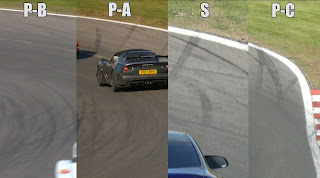 We set all of the cameras to their standard settings so that we could compare the colours and understand which colour-style we should base the project around. Of course, there would still be colour grading in the edit, but if we can match the cameras to our favourite, in-camera grade, that will save time in the edit.
We set all of the cameras to their standard settings so that we could compare the colours and understand which colour-style we should base the project around. Of course, there would still be colour grading in the edit, but if we can match the cameras to our favourite, in-camera grade, that will save time in the edit.When I initially observed the footage, I thought PA had the best colour tones as it looked nice and warm, however, upon further inspection, it is almost too warm, having a yellow tint too it. Both PA and PC have inbuilt grading tools that allow you to change the White Balance according to the weather, Sun, Overcast, Indoor etc. I think we can play around with these tools and ensure all the cameras look similar. I think that PC has the most natural colours, but this is not helped by S which was struggling to focus on the cars, as I think we forgot to turn off face tracking so it was not finding anything to focus on. If that is turned off, I think S and PC both have a very similar tone and with a little bit of warmth added, they will look TV Quality.
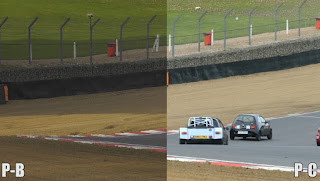 We set up on multiple locations around the track and kept getting a similar result, PC was seemingly the best and most natural tones, but the focusing could have been better. Likewise, with the S, it could have focused better, but it was set to Autofocus where all the rest were on Manual. The PB was fine but it really was shooting washing out footage, we needed more time to "re-learn" the camera after having nearly a year of not using it, but with some small tweaks we could match the colours to PC. As for the focusing of PB, that is more down to practice and we did not have a lot of time as George had us on a tight schedule.
We set up on multiple locations around the track and kept getting a similar result, PC was seemingly the best and most natural tones, but the focusing could have been better. Likewise, with the S, it could have focused better, but it was set to Autofocus where all the rest were on Manual. The PB was fine but it really was shooting washing out footage, we needed more time to "re-learn" the camera after having nearly a year of not using it, but with some small tweaks we could match the colours to PC. As for the focusing of PB, that is more down to practice and we did not have a lot of time as George had us on a tight schedule.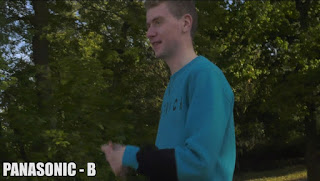 After doing some comparison tests of the cameras, we decided to practice the PTC's and decide which camera we should use for that. Due to native frame rates, we had narrowed the cameras down to S and PB for the PTC shots as they had slightly higher rates meaning footage was less likely to be blurred in movements. We started with PB and Cailan was really struggling to walk and focus the camera at the same time. When we reviewed the footage, we realised that the camera also really struggles to maintain a steady picture while walking on rough terrain. The footage was shaky and it was consistently messing with the framing, my head sometimes is a long way outside the COF. We decided to see how the S did. With its optical image stabilisation and incredible autofocus with faces, it provided us with a much smoother shot. It was not as "perfect" as a stabilised image, but we did not want that, as this will be an actuality sequence. Movement is still needed to make these scenes feel natural. Too much stabilisation would kill the tone and that is something we are very conscious of. The S was much better in all areas, video quality, focus and ease of use as it is much smaller and lighter than the PB. We decided going forward we would use this camera for the PTC's as it was superior to the rest of the equipment we had.
After doing some comparison tests of the cameras, we decided to practice the PTC's and decide which camera we should use for that. Due to native frame rates, we had narrowed the cameras down to S and PB for the PTC shots as they had slightly higher rates meaning footage was less likely to be blurred in movements. We started with PB and Cailan was really struggling to walk and focus the camera at the same time. When we reviewed the footage, we realised that the camera also really struggles to maintain a steady picture while walking on rough terrain. The footage was shaky and it was consistently messing with the framing, my head sometimes is a long way outside the COF. We decided to see how the S did. With its optical image stabilisation and incredible autofocus with faces, it provided us with a much smoother shot. It was not as "perfect" as a stabilised image, but we did not want that, as this will be an actuality sequence. Movement is still needed to make these scenes feel natural. Too much stabilisation would kill the tone and that is something we are very conscious of. The S was much better in all areas, video quality, focus and ease of use as it is much smaller and lighter than the PB. We decided going forward we would use this camera for the PTC's as it was superior to the rest of the equipment we had.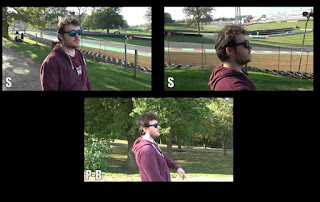 We also played around with the camera angles to see which would work best when walking. Being slightly ahead of the presenter when they are walking looks best and also helps reduce shadows. It also looks better because it is slightly zoomed out, rather than being a close up like Cailan was trying to create when I was walking. I took the control of the camera so that I could understand what this scene was like to film, as well as understanding what shot type worked best. I am glad I did this because I need to decide the shot types for the script, and I need that hands-on experience to ensure I have tried what I think looks good in my mind.
We also played around with the camera angles to see which would work best when walking. Being slightly ahead of the presenter when they are walking looks best and also helps reduce shadows. It also looks better because it is slightly zoomed out, rather than being a close up like Cailan was trying to create when I was walking. I took the control of the camera so that I could understand what this scene was like to film, as well as understanding what shot type worked best. I am glad I did this because I need to decide the shot types for the script, and I need that hands-on experience to ensure I have tried what I think looks good in my mind.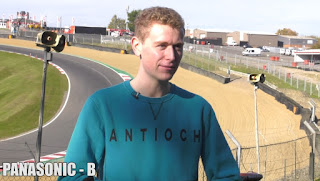 We also tried some static PTC's but these felt really staged and the lack of movement really killed any sort of emotion that we would have built up to by this stage. It also made me look like a presenter, rather than a contributor which meant we decided to not follow this route any further. We quickly realised that we want the majority of this film to be handheld and have constant movement to keep the pace up. We may go static for a couple of hard-hitting scenes, but the majority would include some sort of movement. The static PTC's were easier for Cailan, but he agreed, he wants to challenge himself and try shots that will create the best cinematic effect. Therefore, going forward we decided we should use the S, handheld and be moving when doing a PTC.
We also tried some static PTC's but these felt really staged and the lack of movement really killed any sort of emotion that we would have built up to by this stage. It also made me look like a presenter, rather than a contributor which meant we decided to not follow this route any further. We quickly realised that we want the majority of this film to be handheld and have constant movement to keep the pace up. We may go static for a couple of hard-hitting scenes, but the majority would include some sort of movement. The static PTC's were easier for Cailan, but he agreed, he wants to challenge himself and try shots that will create the best cinematic effect. Therefore, going forward we decided we should use the S, handheld and be moving when doing a PTC.We learnt a lot at Brands Hatch and it was great to come together, even though we are working on separate projects for PP, as it enabled us to get in the spirit of the production and have something to look forward to! We all settled nicely into our roles and were helping each other in this very early phase of the production. We also understood that the wireless clip mic would best for the PTC's. The boom mic would be fine as a backup, but the quality of the clip mic is superior. We will accompany this with Tascam when not using the PB that has a Microphone slot appropriate.
Buckmore Park Location Recce
We were not going to Buckmore Park as a possible filming location, rather just giving the crew an opportunity to practice filming Go Karts as they had not done that either. Buckmore Park will not be the track we use as I have never been there and it has no meaning to the story. However, it was worth looking around the location just in case we ever did come here to film.
Transport connections were good for car drivers as it is located just off the M2 Motorway, but no train station was close to the track. The facilities were great with there being a central hub where food, toilets and areas to sit were located. Power outlets were also available in the central hub which would give the crew an opportunity to charge equipment if it was needed. As Go Karting is still a form of motorsport, hazards do present themselves with the possibility of a kart losing control. There are safety barriers located around the track that we were told to stay behind. The area was tarmacked meaning loss of footing was not an issue unless there was rain. Space was limited but the employee at the track said we were not in anyone's way, wherever we filmed which was good to hear as we were worried at first that the location was rather limited in terms of space. Overall the location was safe to film at and gave some good shots which I will speak about in the camera test section. This part of the day was only really meant to practice filming Go Karts as we will have a scene in our documentary which includes me in a Kart. However, it is worth knowing that this track has a lot of positive features for filming which we can take into consideration for future events.
Buckmore Park Camera Test
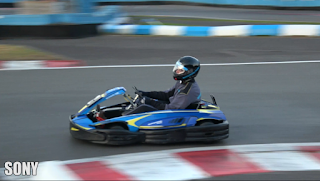 We went to Buckmore mostly to give us a chance to understand how best to film a moving object. We did do a little bit of panning at Brands Hatch, but that was more about comparing the cameras.
We went to Buckmore mostly to give us a chance to understand how best to film a moving object. We did do a little bit of panning at Brands Hatch, but that was more about comparing the cameras.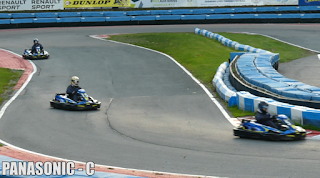 At Buckmore we spent around an hour on three separate cameras, trying out shots and trying to be unique and original, trying to create a shot that looked like it was intense or was action-packed. I used my Sony, Cailan his Panasonic and George had the big Uni Panasonic. We all moved around the track and I helped as much as possible as I had done a lot of motorsport filming in the past. The most difficult part is definitely judging the speed of the pan and ensuring you do not go too fast and create a blur or miss the vehicle with bad framing.
At Buckmore we spent around an hour on three separate cameras, trying out shots and trying to be unique and original, trying to create a shot that looked like it was intense or was action-packed. I used my Sony, Cailan his Panasonic and George had the big Uni Panasonic. We all moved around the track and I helped as much as possible as I had done a lot of motorsport filming in the past. The most difficult part is definitely judging the speed of the pan and ensuring you do not go too fast and create a blur or miss the vehicle with bad framing.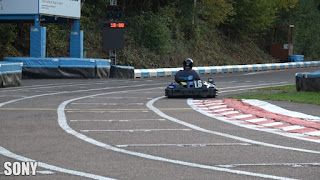 A mix of handheld pans along with some fixed tripod shots will enable us to create an intense sequence. They need to be accompanied by each other otherwise the sequence will be all over the place and no "down time". One sequence cannot be constant action, to appreciate the action we need to be brought further out and have a moment of stillness and silence. If everything is fast paced and full of action, it does not give the perspective of speed in the action sequence.
A mix of handheld pans along with some fixed tripod shots will enable us to create an intense sequence. They need to be accompanied by each other otherwise the sequence will be all over the place and no "down time". One sequence cannot be constant action, to appreciate the action we need to be brought further out and have a moment of stillness and silence. If everything is fast paced and full of action, it does not give the perspective of speed in the action sequence.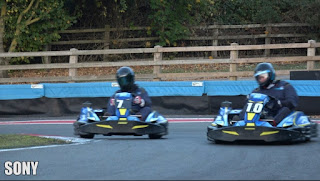 Something that is important in motorsport videography is using the iconography of the track to create an interesting shot. For example, you can see the shots I took on the sony use the lines on the track, to create a cinematic effect which draws the viewer in. You can see on Cailan's shots that he is not exactly sure what to film or what angle is best, which is fine as it is a learning experience and I have been able to point this out to him. You have to see where the karts are driving, to understand the racing lines and track perimeter including iconography to create a shot which looks visually pleasing.
Something that is important in motorsport videography is using the iconography of the track to create an interesting shot. For example, you can see the shots I took on the sony use the lines on the track, to create a cinematic effect which draws the viewer in. You can see on Cailan's shots that he is not exactly sure what to film or what angle is best, which is fine as it is a learning experience and I have been able to point this out to him. You have to see where the karts are driving, to understand the racing lines and track perimeter including iconography to create a shot which looks visually pleasing.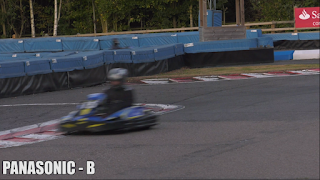 Overall the shots we a good start. They helped us have a chance at panning and using a tripod and understanding how is best to film a kart. I need to make sure that it is made clear in the script for them, that we want to create a sequence that is intense and action-filled. We need punchy shots with close-ups and ultra close-ups. These are hard shots to create, but with some experience and at our level we should all be able to create them. It was a long day, but a lot was learned and it was important to keep in tough in PP while we are working on our separate projects.
Overall the shots we a good start. They helped us have a chance at panning and using a tripod and understanding how is best to film a kart. I need to make sure that it is made clear in the script for them, that we want to create a sequence that is intense and action-filled. We need punchy shots with close-ups and ultra close-ups. These are hard shots to create, but with some experience and at our level we should all be able to create them. It was a long day, but a lot was learned and it was important to keep in tough in PP while we are working on our separate projects.


































